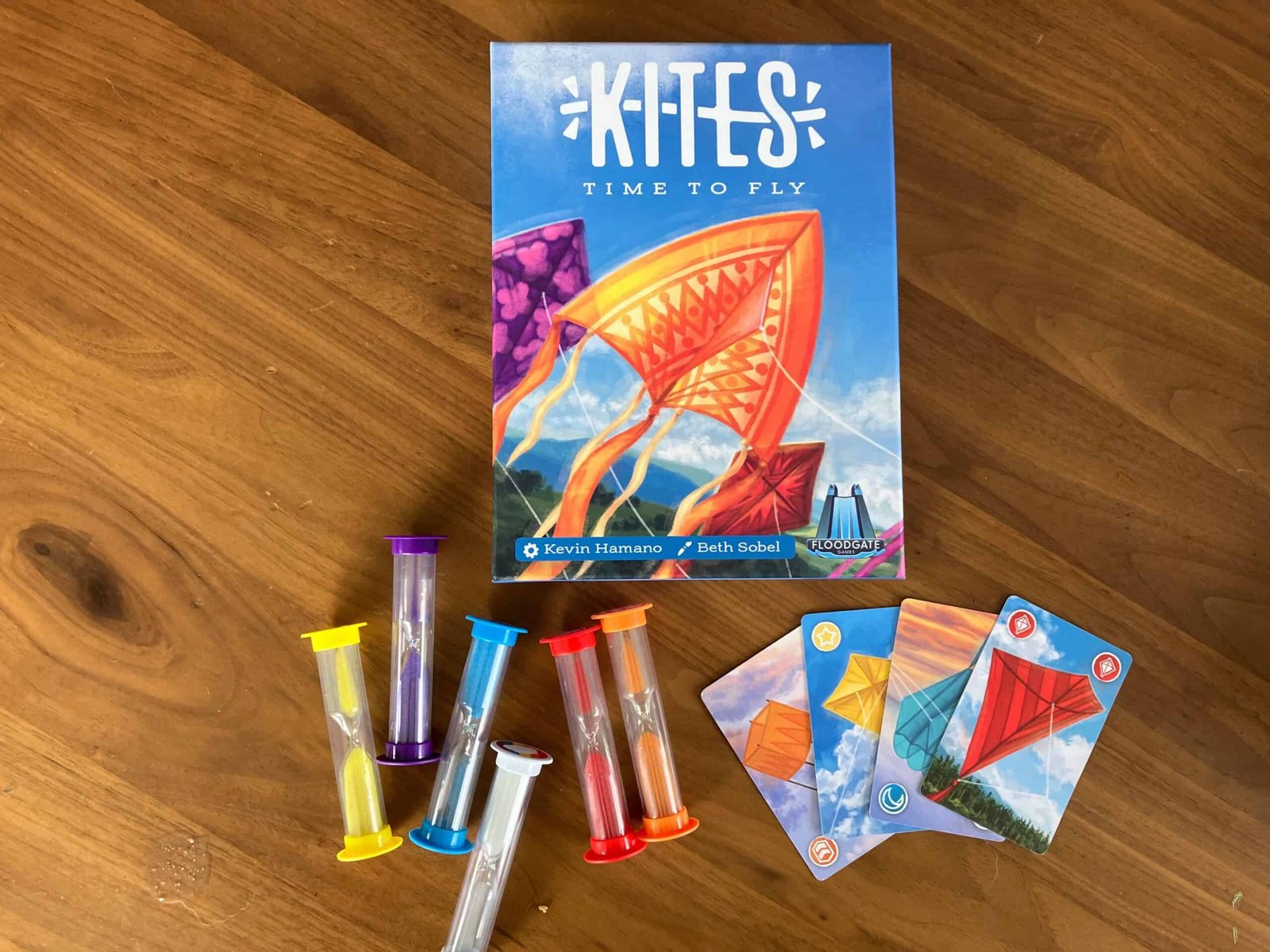
Floodgate Games | 10-15 minutes | 2-6 players | 10 years and up
Kites: Time to Fly is a cooperative, real-time board game that will have everyone on the edge of their seats, taking turns playing cards and flipping over the sand times and keeping their figurative kites in the air, by avoiding any of the timers running out.
It’s definitely one that will get the group rowdy: shouting out “red, red, red” or “blue and orange, blue and orange.” Sound a bit like some nonsensical fun? It absolutely is and is a full-energy party game that will have everyone engaged and cheering each other on.
Let’s dive in and see what all the fuss is about.
What is Kites Board Game?
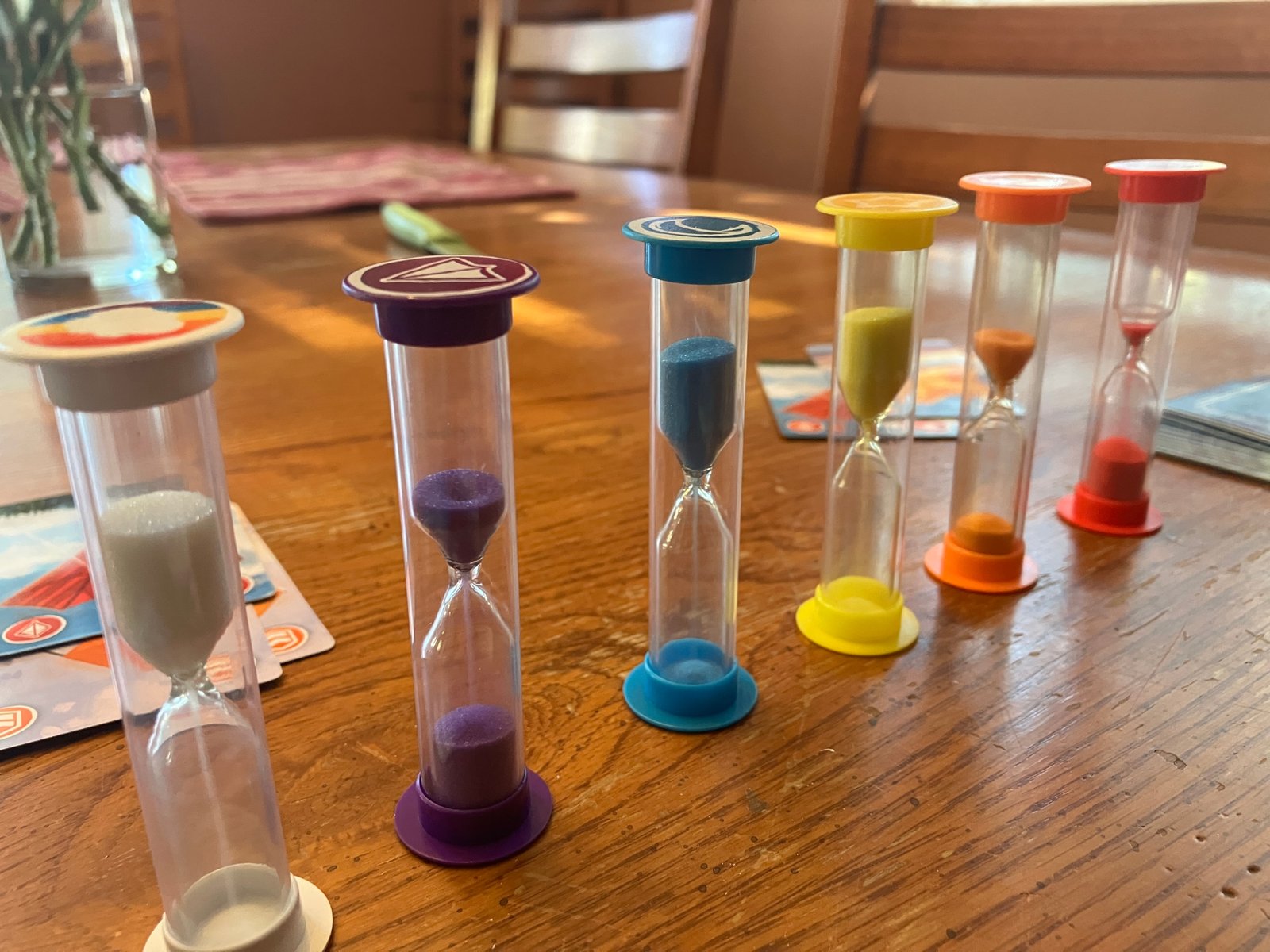
Kites is a cooperative, real-time game, meaning players are all working together, racing the clock to take certain actions, in real-time – unlike most board games, where everything is abstracted.
You are dealt a hand of kite cards with different color symbols on them – these symbols are meant to symbolize the various kites represented by colorful sand timers placed in the center of the board.
As the timers run out, players will need to strategically play their cards, flipping the sand timers that correspond to the color symbol on the card. If any of the timers run out, the game ends and players count up the remaining unplayed cards.
Anything short of zero might feel like a loss, but it is a challenging game and that likely won’t happen on your first few plays. There is a scoring system based on the number of remaining cards.
Artwork
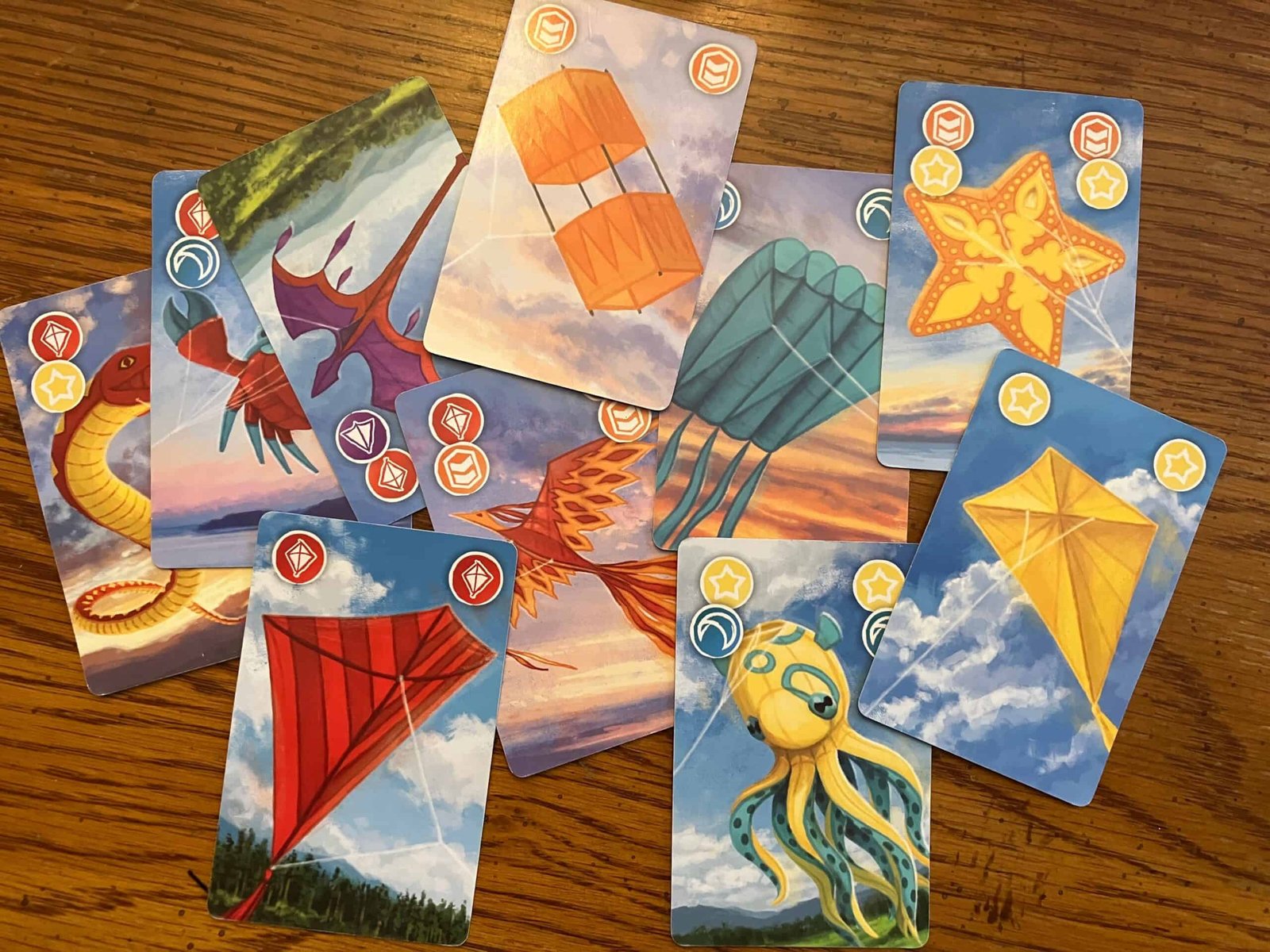
I have to call attention to Beth Sobel’s art. She is of course famous for her work on games like Wingspan and Cascadia, and has done a fabulous job here as well. The art on the kite cards and box is lovely and inviting which makes it easy to get to the table.
To be fair, the artwork is relaxing and lovely, and the game is stressful and intense, so while I love the artwork, the pace of the game doesn’t exactly match. Not in any way a problem, I only point it out in case you trying to talk someone into getting off the couch and coming over to join you at the table and you said “Hey, look at this relaxing inviting art.” They may agree, and come to the table expecting a nice, quiet tile-laying game…
But that’s no problem. Come for the art, stay for the manic group shouting match, that’s what I say.
Game Components: Kite Cards and Colorful Sand Timers
The kite cards are decent quality, but like any cards, they aren’t nephew-proof, so if you have the same type of nephews as I do, you may want to let them know that they need to flip the timers quickly. They do not need to aggressively slam the cards down causing them to bend…
Nephews… you are required to love them.
The timers however are nephew tested and approved. They are high quality and can take whatever your playgroup can throw at them.
How to Play Kites Board Game
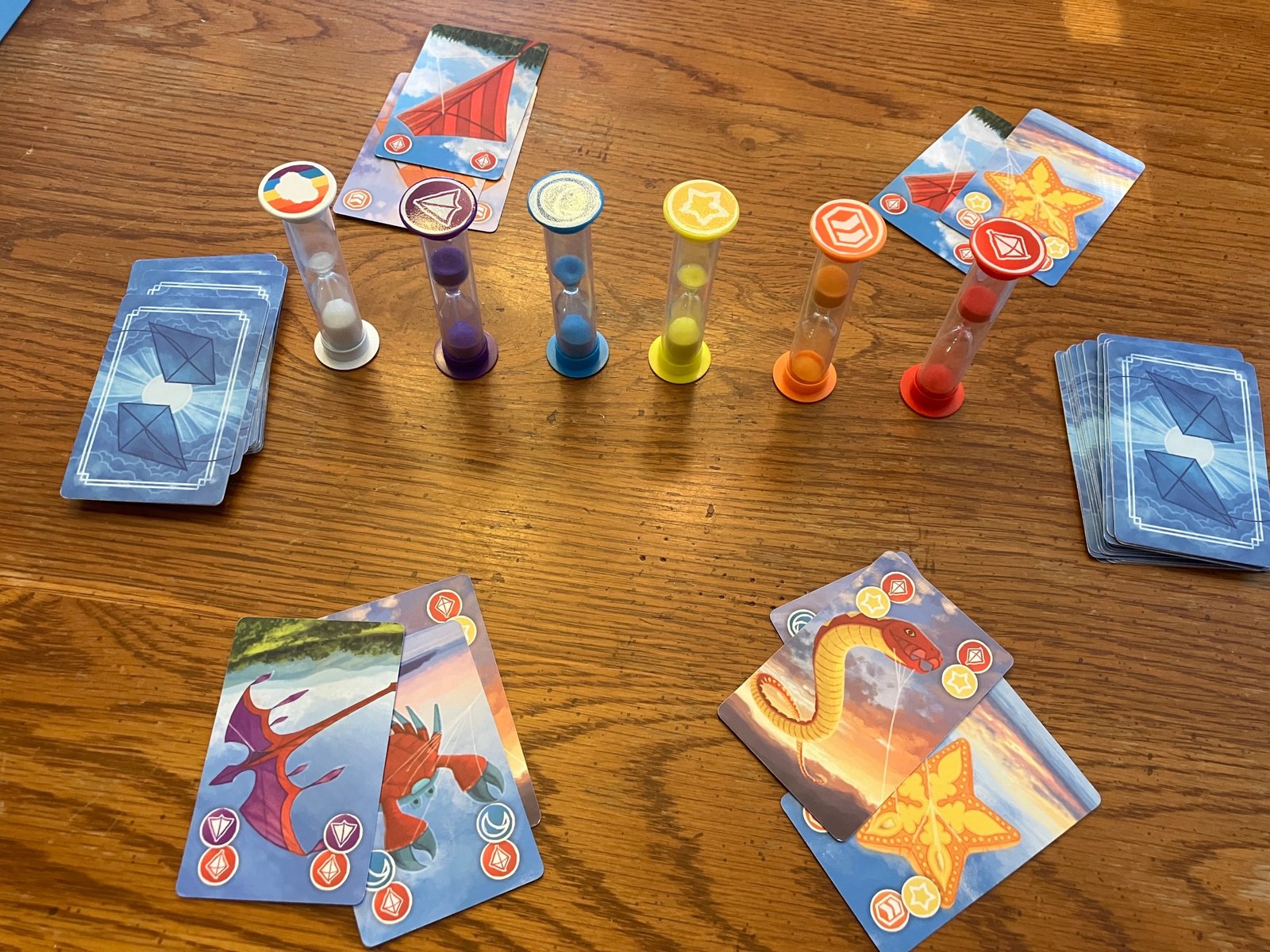
Set up Kites Board Game
Place the six colorful sand timers place them sideways on the table. Make sure that the sand is all on one side before doing so – don’t want to be starting at a disadvantage. It’s important that all players be able to reach all timers, so try to sit for optimal access.
Shuffle the deck of kite cards and deal out a number to each player based on player count. Place the remaining cards where everyone can get them. Multiple draw piles are usually best, so no one has to reach across the table, which, in this game, could spell disaster.
You’ll pick a starting player (let’s say, the last person to fly a kite), flip the white sand timer up, and start playing.
How to Play Kites Board Game
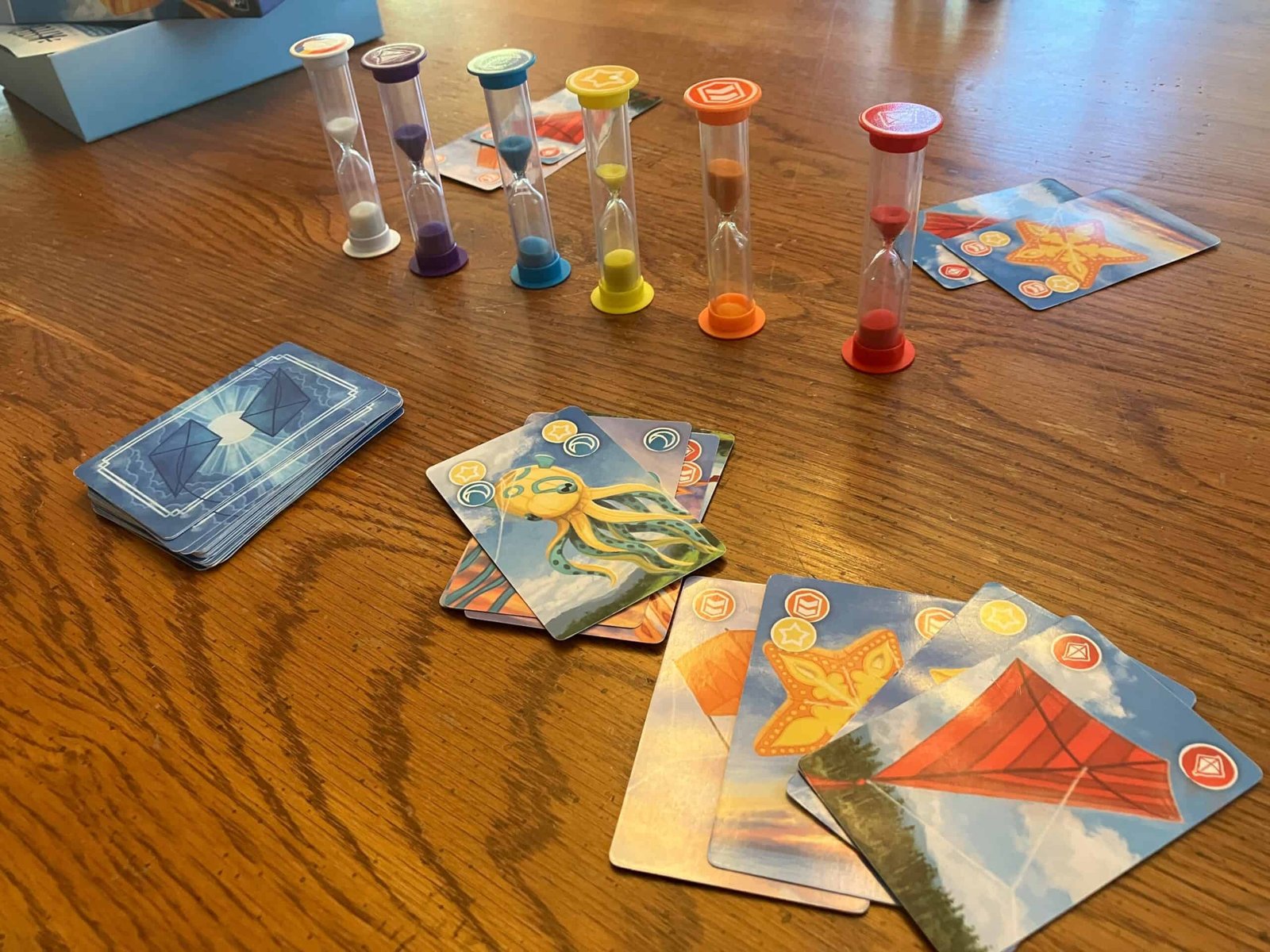
Players will take turns playing cards from their hands. For each color symbol on the played card, they will flip the corresponding sand timers. Some cards have one and some have two. Note that there are no white timer cards. The only way to flip the white timer is by playing a single of any color. Double cards cannot be used to flip white.
The timers run at different speeds from red being the fastest and purple being the slowest – white is the slowest of all – so different timers will require more attention than others over the course of the game.
At the beginning of the game, timers are stood up and side-facing up when they are first played. Once they are played they are flipped back and forth, but until they are first played they remain on their side.
When the last card from the deck is played, the white timer may no longer be flipped. Players have to get all of the cards out of their hands before the white timer runs out. therefore is it pretty important to time flipping the white timer to correspond with the final card being drawn.
If any of the sand timers run out and any time during the game, the round ends, and players count up all remaining unplayed cards – which is the team’s score. They can work to improve their score by decreasing the number of remaining cards at the end of the round.
Strategies for Success
It is important for players to work together, using sand timers and coordinating to keep all their kites in the air. Communication is open and fully encouraged. If you see a timer running, don’t be shy – make a fool of yourself shouting “orange, orange, orange.” If you are going next and have the right colored card, let everyone know, and by all means, be smug about it.
It is a cooperative game and it is all about working those sand timers and coordinating plays.
In our experience, speed is often more important than strategy. Playing cards is how you win, so don’t get too caught up in optimal play
Advanced Gameplay: Complication Cards For the Truly Elite
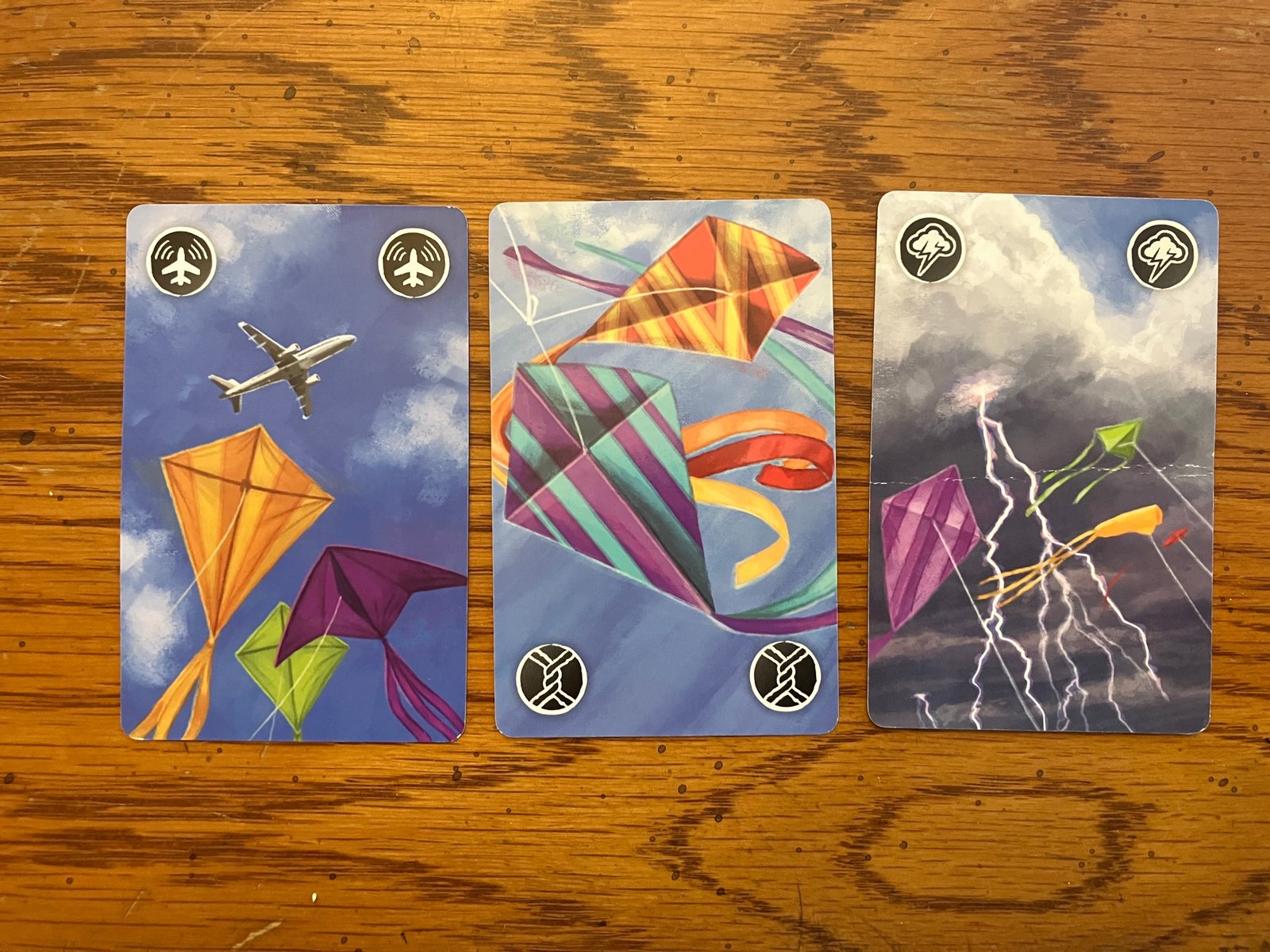
They’ve also included three additional challenges in the box for players who consistently keep all their kites in the air. Each challenge adds four cards to the deck that have a negative effect when played. When one of these cards enters your hand, you have to play it on your next turn.
Thunderstorm: when you draw a thunderstorm card, you immediately announce “A Storm is Coming.” On your next turn you must play the storm card and only the storm card, flipping all timers simultaneously. Makes for some scary but exciting turns.
Crossed Lines: When you draw crossed lines, you are required to play it the next turn, but cannot announce it. On your turn, you’ll play it, announcing crossed lines and all players trade one card with the person on their left and right. It’s a mess and certainly throws a wrench in your plans.
Airplane: When you draw an airplane card, you cannot say, but you are required to play it the following turn announcing “airplane!” Until your next turn, no one can communicate anything to any other players. In a game all about coordinating with other players, this can be a killer.
These additional challenges can be included on their own, or together in any combination to dial in the right difficulty for your group.
Review
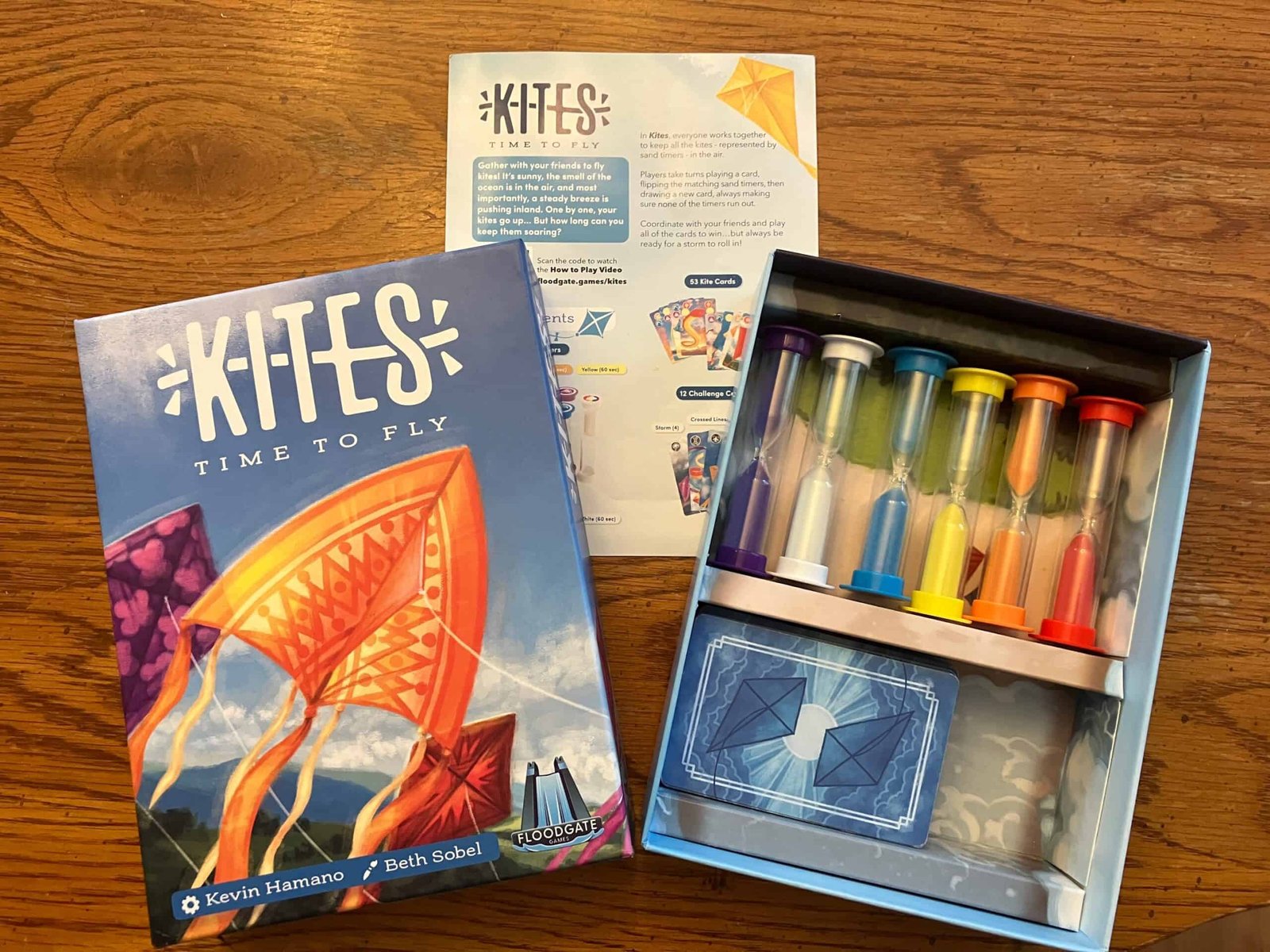
I love having this in my party game collection because it brings a different pace and feel. It’s frantic and sometimes maddening, but bring just what we need to wake everybody up after dinner and set the tone for a fun game night.
It also works really differently at different player counts but is great all the way from two to six. Two and three is more meditative and you get into a rhythm with your team and flipping the sand timers feels really definitive and purposeful. Five to Six is a mad dash with everyone just taking turns playing cards flipping the sand timers in the air, knocking everything over all the time. Just what you want for a group cooperative game.
Four is probably about perfect in terms of finding the balance between the best this game can offer. Still chaotic and challenging like with the big group, but you have more cards in your hand and feel like you are actually making choices. And, logistically, easier to reach all the timers and you can have two draw decks that are easy to reach as well.
I’ve found with this one, that I tend to pull it out either as a filler or to kickstart a game night, but a lot of the time we get a bit obsessed with trying to beat the game, adding more and more complicated cards, until we can clear the deck and everybody wins. It’s like the Mind or The Crew in that way, where you keep wanting to try just one more. And it’s quick enough that you can just shuffle up and try again.
Summary
Unique Cooperative Gameplay: The game emphasizes teamwork and coordination, relying on players to manage sand timers and play cards in sync.
Flexible Player Count: Suitable for 2 to 6 players with different experiences based on player count, from meditative with fewer players to frantic with more.
Strategic and Fast-paced: Balances the need for speed with strategic card plays, making each game session exciting.
Advanced Challenges: Includes optional complication cards like Thunder Storm, Crossed Lines, and Airplane for increased difficulty and variety.
Engaging and Replayable: Quick rounds encourage repeated play, with a constant drive to improve the team’s performance and beat the game.
Great for Social Gatherings: Ideal for parties and game nights, providing a lively and interactive experience that’s different from traditional board games.
Conclusion: Bring on the Sand Timers
This really is a lovely production from Floodgate Games and an easy recommendation for pretty much any board game collection – from the wonderful art style to the intense and engaging gameplay this is an all-around winner.
It’s also a unique game that adds another dimension to your collection. It’s highly engaging, fast-paced, and high energy. Not every game offers that, so it’s nice to have this one to pull out when that’s what the evening calls for.
Pick up a copy and grab some friends from some sand timer mayhem.
We recommend this as one of our best party games. Check out that article for more recommendations.
FAQ
What is the main objective of this cooperative game?
The main objective is for players to work together, managing sand timers and playing their cards to keep all their kites in the air. Coordination and communication are key to succeeding in this fast-paced game.
How many players can enjoy this game?
Kites Board Game is flexible and suitable for 2 to 6 players. It offers a different experience depending on the player count, from a more meditative gameplay with fewer players to a chaotic and frantic pace with more.
What are the advanced gameplay challenges?
The game includes optional complication cards for advanced players. These cards include Thunder Storm, Crossed Lines, and Airplane, each introducing unique challenges that increase the difficulty and variety of the game.
Is this a good game for parties and social gatherings?
Yes, this game is perfect for parties and game nights. Its unique cooperative gameplay, engaging mechanics, and lively pace create an interactive experience that’s ideal for social gatherings.
How does the player count affect the gameplay?
With fewer players (2-3), the game feels more meditative, allowing players to get into a rhythm. With more players (5-6), the game becomes a mad dash, adding to the chaos and excitement. Four players offer a balance between strategy and chaos, providing a well-rounded experience.
What makes this game different from traditional board games?
The game emphasizes teamwork and real-time coordination, relying heavily on managing sand timers and strategic card plays in sync. This sets it apart from more traditional turn-based board games, offering a unique and fast-paced experience.
How replayable is this game?
Kites Board Game is highly replayable due to its quick rounds and the constant drive to improve the team’s performance. The addition of complication cards for increased difficulty and variety also enhances its replayability.
Why should I add this game to my board game collection?
This game is a unique addition to any board game collection due to its engaging, fast-paced, and high-energy gameplay. It offers a refreshing change from traditional games and provides an exciting challenge for players of all skill levels.
